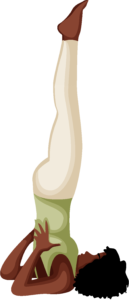Shoulder Stand (Sarvangasana)
Pose Overview
| Common Name | Shoulder Stand |
| Traditional Sanskrit Name | Sarvangasana |
| Sanskrit Name Pronunciation | sahr-vahn-GAHS-uh-nuh |
| Pose Difficulty | Beginner |
| Drishti
Drishti is the gaze or visual focus point during yoga poses.
Learn more about Drishti |
Tip of the nose |
Shoulder Stand, also known as Sarvangasana, is a yoga pose that is considered to be an inversion pose. This means that the heart is positioned higher than the head, and it is said to have a balancing effect on the body, both physically and mentally. It is a beginner-friendly pose and can be modified to suit different levels of flexibility and strength. The traditional Sanskrit name for this pose is Sarvangasana, which can be translated to "all-limbs pose."
Benefits of Shoulder Stand
Shoulder stand is beneficial for the entire body. It strengthens the shoulders and neck, improves balance, and can help alleviate stress and tension. It is said to stimulate the thyroid and parathyroid glands, which helps regulate metabolism, and it also helps to improve digestion and elimination. Additionally, it can help to improve blood circulation and energize the body.
How to Enter Shoulder Stand
Begin by lying on your back with your knees bent and your feet on the floor. Bring your hands to your lower back, fingers pointing down. As you inhale, press your hands into the floor and use the strength of your legs to lift your hips and lower back off the floor. Continue to press your hands into the floor and lift your hips higher until your legs come off the floor and your body is in an inverted ‘L’ shape. Support your lower back with your hands and straighten your legs, coming into Shoulder Stand.
How to Exit Shoulder Stand
To come out of Shoulder Stand, bend your knees and lower your legs back down to the floor. Bring your hands to your lower back and use your hands to support your lower back as you lower your hips to the floor.
Common Shoulder Stand Modifications & Variations
To make Shoulder Stand more accessible, you can use a wall for support. Place a folded blanket against the wall and then come into the pose with your shoulders against the wall. To modify for more flexibility, you can bring your legs straight up to the ceiling, coming into Plow Pose.
Common Mistakes with Shoulder Stand
Not engaging the core muscles enough, which can cause the lower back to sag. Not keeping the neck in line with the spine, which can put unnecessary strain on the neck muscles.
Safety Guidance
Shoulder Stand can be hard on the neck, so it is important to make sure that the neck is in line with the spine and that the core muscles are engaged to support the lower back. If you have any neck or shoulder injuries, it is best to avoid this pose or to practice it with the guidance of an experienced teacher.

